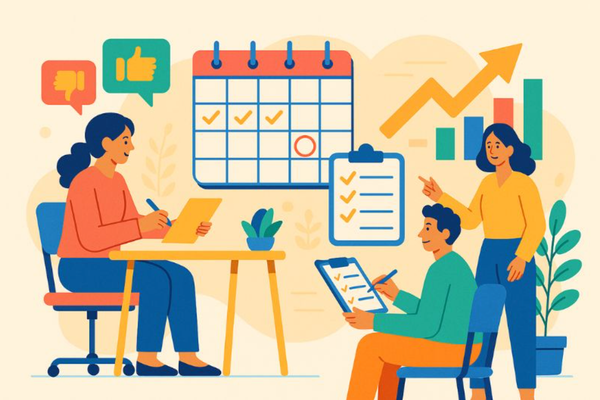How to minimize Zoom fatigue: Remedies for the modern worker
Much of the exhaustion that comes from video calls is about cognitive load, and increased concentration on verbal and nonverbal cues.

While virtual meetings have made it possible to continue activities in an increasingly remote working environment, they have also introduced a new challenge: Zoom fatigue.
The convenience of video conferencing is often offset by mental strain and emotional fatigue.
According to this report from researchers, the popular video conferencing platform Zoom had 10 million participants daily. By April 2020, that number had risen to 300 million! This trend towards video meetings isn’t slowing down either, with Zoom logging $4.6 billion in revenue for 2024. [1]
If video conferencing is set to continue, then strategies to combat Zoom fatigue are vital for modern workers, because mental health matters amidst technological advancement and increased remote interactions.
Why are we exhausted by endless Zoom calls?
Much of the exhaustion that comes from video calls is about cognitive load, and increased concentration on verbal and nonverbal cues.
Cognitive load
In short, the term cognitive load is used to explain how many pieces of information the brain can process at any one time.
Cognitive overload occurs when the amount of information coming at a person is greater than the brain's capacity for processing it. Even the most intelligent person can suffer from cognitive overload, because it’s not about intellect but rather processing power, which is similar for everyone.
One group particularly vulnerable to cognitive overload is remote workers. With an expectation to manage video meetings as a natural part of their working day, they are catapulted into a range of situations and technological challenges they may not have the skills to manage. It is therefore even more important to keep remote workers engaged with their team, and supported.
Tackling Zoom fatigue begins with an understanding of what causes it, and this provides the pathway for creating strategies to combat it.
Here we discuss three major causes of cognitive overload.
1. Processing nonverbal cues
With in-person meetings, we instinctively gauge body language, tone, and context.
Have you ever watched two people dancing? Did you see the interplay of movement and rhythm?
In face-to-face meetings, communication is also an interplay of movement, timing, gestures, and words that help us to understand context. Typically, there is time to process the nonverbal cues and stay connected to one speaker at a time.
In some Zoom meetings, non-verbal cues are restricted, delayed, and missing due to technological limitations. At other times, the number of participants makes the ‘dance’ chaotic, instead of smoothly flowing. The result is cognitive overload.
On one hand, you don’t have enough information to understand the context. On the other hand, you’re trying to manage too much information at once.
2. Split attention
Unlike phone calls, where we merely listen to another person’s voice, video conferencing requires us to pay attention to the faces, actions, and body language of multiple people, as well as ourselves. This intense focus on others and ourselves is unnatural, and something we’ve only learnt since the virtual conference room became popular.
In personal interactions, people mirror one another’s actions as a sign of agreement. This becomes a soothing gesture that makes us feel understood. When you’re staring at multiple faces on a small screen, emotional fatigue increases as you search the ‘audience’ for signs of understanding. [2]
3. Navigating an unfamiliar situation
Humans have become familiar with face-to-face interaction and are well instructed in the ‘rules of engagement’.
However, video meetings introduce more eye contact than we’re used to, facial non verbal communication as the only body language cue, and proximity that we’re only used to in intense situations. The energy spent on managing this unfamiliar environment can be exhausting, and for some, far too much to handle. [3]
These factors are the major contributors to Zoom exhaustion, and after a long day of back-to-back video meetings, it’s completely understandable why you feel wired, have a pounding headache, and feel like you’ve been in a non-stop theater performance. The question that begs an answer is: How can we combat zoom fatigue if it's so damaging to our mental health?
Strategies to combat Zoom fatigue
Preventing motivational fatigue and cultivating healthy habits is crucial if video meetings are the future. By tackling the source of the problems, we can develop effective strategies for long-term management of Zoom fatigue.
1. Run structured meetings with the focus on one speaker at a time
Unstructured meetings worsen cognitive load. By taking charge of the interactions and assigning roles of speaker and time-keeper, and limiting the number of people who speak at one time to a single person, you can reduce cognitive load.
Assign small breaks during a long meeting. This will avoid eye strain and give participants more energy when they return to the meeting. They’ll also absorb information better because they’ve had a short break (5 minutes).
2. Alternatives between in-person meetings, phone calls, and video calls
If it’s possible, alternate between in-person meetings, phone calls, and video calls. For example, hold daily check-ins online, weekly video calls, and monthly real life meetings. There are also fun ways to do meetings that are not about video calls.
If you live in Slack, integrate an app like Stany Standup, which allows you to automate daily standups (check-ins) and get your whole team on the same page. By reducing video meetings, or changing up the way you meet, you provide a well-needed break from Zoom or other conferencing platforms. This way of doing things is more natural, fun, and personal.
Unless you need to have a video call, do a phone call instead. This reduces the need for team members to be ‘seen’ all the time, contributing to cognitive overload and mental fatigue. Honestly, sometimes you just want to wear a comfortable sweater or old track pants, without worrying if the boss can see you.
3. Reduce social fatigue
One of the main contributors to the social fatigue of video calls is split attention and the mirroring effect - checking what others are doing, their backgrounds, and focusing on our own image while trying to concentrate on the speaker. To reduce this impact:
- Hide self view - This will prevent you from seeing your own video feed while still allowing others to see you. You get to take a break from staring at yourself, which reduces the need to manage your every movement and physical appearance.
- Use speaker view - This automatically displays the active speaker’s video in the main window, and reduces other videos to thumbnails. This prevents you from looking at what everyone else is doing.
4. Avoid multitasking
While multitasking might feel productive during a meeting, it's actually the opposite. Writing notes, making coffee, tossing in a load of washing, and trying to deal with your kid crawling across the kitchen floor while your meeting is on, is difficult and stressful.
Also, if you’re answering emails while half-heartedly listening to the Zoom meeting, you’re likely not doing a good job of either. It’s essential for your sanity and stress levels that you are fully present in the meeting, even if you don’t have your camera on.
5. Don’t make every meeting compulsory for everyone
While it may seem like a good idea to involve everyone in meetings (mainly so that everyone is in the loop), it may be causing unnecessary strain on participants. Aim to keep the number of participants to those who will actively contribute to the objectives of the meeting.
If you’re having an open meeting where everyone can attend, but don’t need to, make that clear when you set up the meeting.
Worried about getting your remote team together for social interactions online? There are other ways to keep your team connected. Virtual coffee chats are becoming increasingly popular for connecting team members. Set up these apps in your main communication platform, and assign chats between team members.
Also, don’t run a meeting to find out how people feel about recent changes to paid time off, or what incentives they would like for top performers. Just run a poll and get super fast results, without gathering everyone together.
Combat Zoom fatigue with five easy strategies
If video conferencing is causing mental and emotional fatigue in your team, then you need to tackle it right away by implementing these five easy strategies:
1. Run structured meetings that focus on one speaker at a time.
2. Alternatives between in-person meetings, phone calls, and video calls.
3. Reduce social fatigue.
4. Avoid multitasking.
5. Don’t make every meeting compulsory for everyone.
By changing things up and integrating simple-to-use and fun apps for standups, coffee chats, and polls, you can reduce the number of video meetings and still get everything done.
Don’t let chronic cognitive overload bring your team down any longer. With a few small changes, you can make a big difference to their motivational levels and performance.
References:




